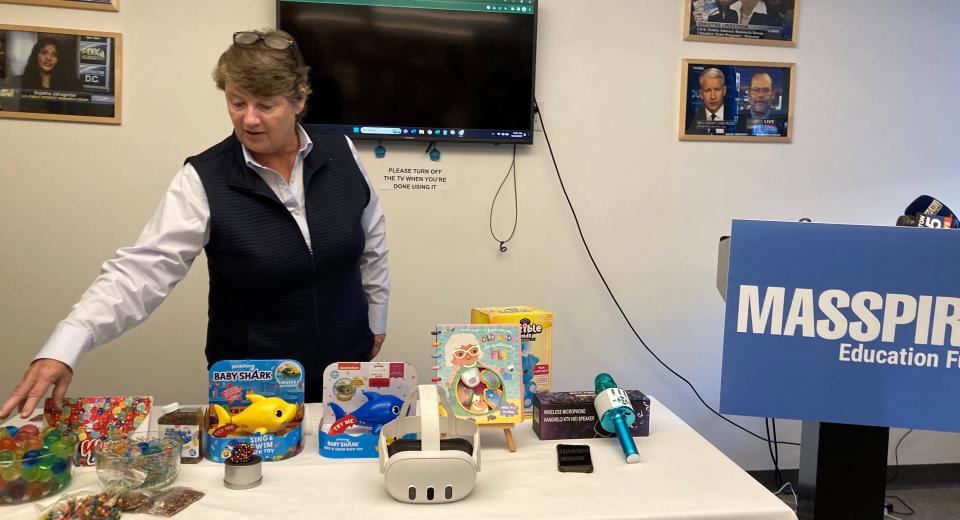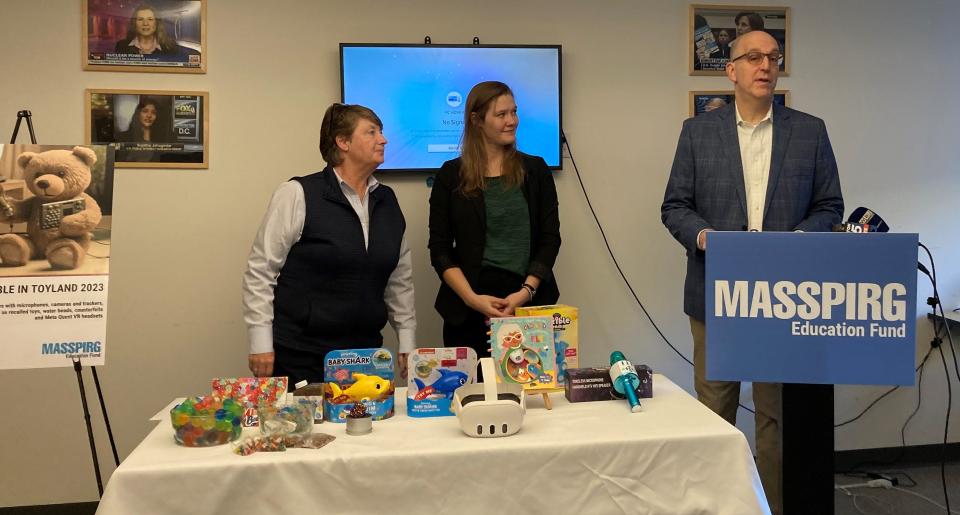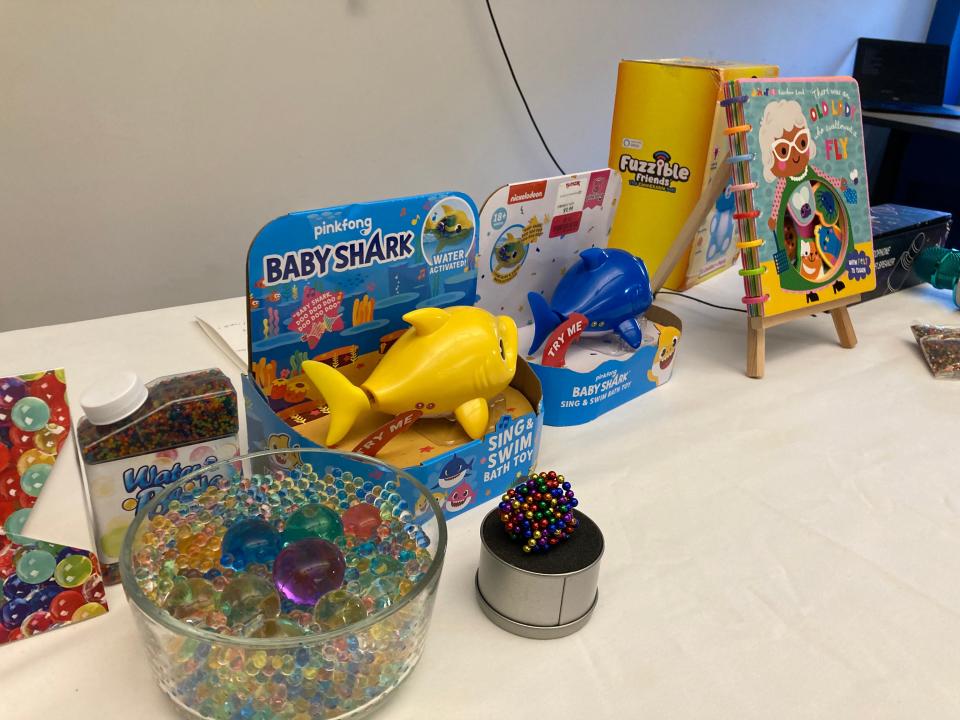In time for holiday shopping: list of troublesome toys posing health risks for kids
Imagine 10-year-olds sitting in a darkened room, around a table with "friends," discussing whom to kill in a game of Russian roulette. With virtual reality goggles marketed as appropriate for children as young as 10, the "pretend game" feels all too real.

The goggles and other smart toys are on the 38th edition of Trouble in Toyland, the annual listing of holiday toys that pose hazards for children released by the Massachusetts chapter of the Public Interest Research Group.
These artifacts, said Deirdre Cummings, consumer program director at MassPIRG, have either been recalled after causing significant injuries or deaths, are dangerous if used inappropriately, or are unregulated and untested for their lasting effects on children's eyes, ears, developing brains and emotional well-being.
While the list toppers are the interactive or smart toys, toys that connect to the internet, others were included because of their composition (hard plastic), size or uses. These include water beads that expand with moisture, tiny, extra-strong magnets that can tear through flesh if swallowed or used as “jewelry,” and even a board book held together by plastic rings that can come off and cause a choking hazard.

What’s a parent to do?
Read up on the technology, look for privacy statements, data collection and use policies, understand the features and understand how a device operates. Information is a parents’ best tool in picking a toy that is appropriate for their children.
As for the smart toys, “there’s a host of concerns with these toys,” said R.J. Cross, director of Don’t Sell My Data at MassPIRG.
These concerns, Cross said, include the gathering of the user’s data from ages, birthdays, emails and credit card information to biometric movement data, tracking eye motions, and body motion. Such information can correctly predict age, gender, physical fitness and disabilities.
“One hundred seconds of movement data is enough to identify a person as accurately as a fingerprint,” Cross said. Internet access works both ways; while children are on-line playing, the toy could be accessed by others, exposing children to being contacted inappropriately by strangers.
Even more worrying for the consumer watchdogs is that these devices are being marketed as appropriate for children as young as 10.
“We assume that when new technology and devices are developed for children, that they have been tested and have been proven to be safe for children,” said David Monahan of Fairplay, a Boston-based national organization that monitors online safety for children while encouraging nonconnected playtime.

“But that’s not the case,” Monahan said. He said online platforms like Meta, the parent company of Facebook and Instagram, keep trying to lure younger and younger children into the online world. The company lowered the recommended age for the Horizon Worlds to 13 “in some countries,” according to its official website, and has parental controls for children between the ages of 13 and 17 in other countries.
“We have no knowledge of the impact of these toys on 10-year-olds,” Monahan said. “Smart toys drive play, tell children what to do, stifle curiosity and imagination. Smart toys are not a smart choice for kids.”
In testing the VR goggles for MassPIRG, Cross created an account in which she claimed she was 10.
“It takes time to get used to the device,” Cross said, listing some of the effects, from seasickness and nausea to trouble focusing her eyes even as long as an hour after taking the headset off after 20 minutes of “play.”
Gunplay appropriate for 10-year-old?
As a 10-year-old, Cross accessed Rec Room, which has been described as a popular app. In the first 60 minutes of play, she experienced bullying, “two children chased me around the room we were in, miming hitting motions and yelling that I shot their friend,” saw a swastika drawn on a whiteboard and racked up huge charges on her linked credit card.
When she started a game called Breaking Point, suggested to her 10-year-old self by the app, she found herself in a dark room at a table with other players who were engaged in a game of Russian roulette.
“The whole point of the game is to be the last one standing,” Cross said, explaining the game is very social and players negotiate with each other, deciding which one to shoot.
“It was a very intense, immersive experience, the visual and emotional part feel real,” Cross said. It felt so real that her body reacted as if the experience were real and happening to her. The children chasing her in the virtual room were life-size, as was the gun used in the game.

Even if parents have accepted a certain level of violence when children play 2D video games, the immersive technology should give them pause, Cross said. The immersive technology is used as a desensitizing tool for people suffering from crippling phobias. Cross asked if that is something parents want a child to experience.
In his description of the virtual reality experience, Monahan compared it to sending a child into a room with no windows, where they can’t see and parents cannot enter, but there are adults and other children in the room. What happens there, he said, can range from bullying to exposure to inappropriate conduct, including sexual harassment and violence.
Not all smart toys on the list
Other items highlighted in the report includes water beads. Developed as an aid for children with sensory issues, the beads grow larger when exposed to moisture. Their sizes vary; from as small as an ice cream jimmy to marble-sized.
“There have been 7,000 injuries reported from this item and one death,” Cummings said. If swallowed, the beads can clog intestines and require surgery to remove. One issue is their size and packaging. Cummings displayed a small plastic container packed with 50,000 of the beads. If spilled, they could be picked up by a small child and ingested.
Small magnets that can be manipulated into different sculptural shapes are also dangerous. They are so powerful they can tear flesh if used as “jewelry” cause problems if stuffed up a nostril or can cling together in a child’s intestine, even through the walls of their bowels, if swallowed.
The researchers managed to buy a recalled toy from an online retailer: the Baby Shark, manufactured as a bath toy with a rigid plastic protruding fin. The wet and soapy environment where it was designed to be used could cause a child to fall on the fin and suffer a puncture wound.
And the ubiquitous button battery, used in watches and small electronic devices, also made the list. “There have been 32 deaths and 54,000 injuries in the last 10 years caused by the button batteries,” Cummings said. “They can cause holes and tears in the intestines and chemical burns.”
This article originally appeared on Telegram & Gazette: Deadly and dangerous: toys that shouldn't make the shopping list

